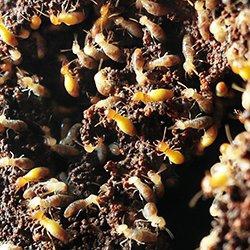Five billion dollars. That’s the estimated amount of money spent by Americans because of termites each year. One of the reasons termites cause so much damage is because they often aren’t spotted until it’s too late. This article will help you identify termites and recognize the signs of their presence so you can get the termite protection you need.
Why Is Termite Activity So Dangerous?
Termites eat cellulose, which is most commonly found in wood. In Hartford, if you have termite issues, you’re most likely dealing with subterranean termites. These pests live underground. Worker termites create mud tunnels and chew tunnels through wood. They never come out in the open since the harsh environment would kill them.
If you aren’t looking for termites, they could be active in your walls for months before you have any idea they are there. You won’t see the worker termites and you won’t notice any mud tunnels unless you’re looking for them since these tubes can be quite small and are usually built in hidden locations. Termites can cause significant damage. Every day that termites are active in your home means more damage to the wooden structures that support your home.
How Can You Identify Termites?
If you don’t see worker termites, and you can’t see the damage until it’s too late, then how do you know if there are termites in your home? During the spring, you can watch for swarmer termites. Swarmers are winged termites that are capable of reproducing. They emerge as a group (swarm) in the spring in order to start new colonies. Whether you see a swarm of termites, a single winged termite, or even shed wings beside windows or doors, it’s time to get help.
The presence of swarmers can mean that there is already a termite colony nearby or that a new colony might soon be starting near your home. Either way, you’ll want to find professional help before they cause too much damage. Once termites get into your home, you may see signs like bowed walls, drooping ceilings, or uneven floors. Termite damage can make it difficult to open and close doors and windows, and it will endanger the structural integrity of your home.
Preventing Termite Damage
If you don’t see any of these signs, now is the time to take preventative measures.
- Fix any moisture problems in your house. This means using a dehumidifier for rooms in the house with high humidity such as the basement, garage, and bathroom.
- Repair leaks. If you have leaky pipes or a leak in the ceiling, it’s imperative that you fix the leak quickly. Water damage will attract termites.
- Replace water-damaged wood. If you have areas of the home with damaged wood, whether from storms, or age, it’s important to replace it. New, hardwood is more difficult for termites to get into, so they’ll be less attracted to it.
- Clear your yard of debris. Termites may first be attracted to your yard and can find food in old stumps, logs, firewood piles, or even cardboard boxes. Clear your yard and you’ll reduce the chances of drawing termites toward your home.
- Invest in termite monitoring from American Pest Solutions. Whether you’ve seen signs of termites or not, we have the tools to help you protect your home. We’ll watch for termite activity and install baiting systems to eliminate termite colonies near your house.
Be proactive in stopping termites by taking preventative measures and partnering with American Pest Solutions for termite control that works. Reach out today for more details or to schedule a termite inspection for your home.

